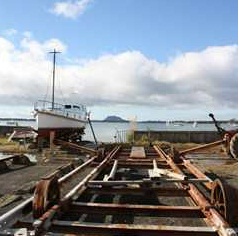Omokoroa Boatyard remediation project

What is the Ōmokoroa boatyard?
The Ōmokoroa boatyard is located outside Tauranga, at 34 Harbour View Road, on the Ōmokoroa Peninsula. It is a privately-owned coastal site, south of the Gerald Crapp Historic Reserve. For several decades, the site has been used for boat storage and maintenance. Part of the original boatyard site, on the harbour side, was on land that has subsequently been vested in Western Bay of Plenty District Council as an esplanade reserve.
What is going on at this site?
The rails, concrete supports, and topsoil are being removed. New soil will be brought in to return the site to about the original level.
Why is this happening?
Due to many years of use as a boat maintenance yard, contaminants have been found in the soils here. Old paint that has been scraped off boats has resulted in lead, arsenic and copper being found in the site's soil at higher than recommended levels. Over a long period of exposure, these contaminants have the potential to be harmful to humans or to the environment and can wash into the estuary during times of heavy rainfall.
What exactly will the contractors be doing?
After removing the rails, cradles and concrete support structures at the site, the contractors will remove an initial surface layer of soil across the boatyard site. This will be tested for contaminants before being removed. In some places on the site, deeper soil will also be removed until tests show that it meets the required quality standards. Imported soil, tested and also free of contaminants, will then be brought in. The site will then be mulched and sown with new grass.
Why is this happening now?
Over the years this boatyard has been in use, New Zealand's environmental laws have changed. It is the job of regional councils, on behalf of central government, to control discharges to the environment and also to monitor for any adverse effects that could impact human health and/or the wider environment. Changes to laws at a central government level have led to the creation of a National Environmental Standard (NES) for assessing and managing contaminants in soils. We need to make sure the site fits within the regulations set out in the NES and the Resource Management Act (RMA).
For more information on the NES, please visit: www.mfe.govt.nz/publications/rma/nes-assessing-soil-protect-health/index.html
How will the soil be tested?
Soil samples will be sent to an accredited laboratory. Some on-site testing will be carried out using portable equipment however, the final confirmation of soil quality will be by laboratory analysis.
What happens to the soil that is taken away?
Soil removed from this site will be placed in a lined, Class A landfill at Tirohia, south of Paeroa. If necessary, this soil will be treated before being disposed of.
How long will the work take?
Earthworks at the site are expected to take about four weeks from mid-June, 2012. However, the site will not be reopened until the new soil has been stabilised by new grass growth. We are working to reopen the public reserve area as soon as possible, however because we are carrying out this restoration during winter, which will hopefully be less disruptive to the public, it could take several months for new grass to grow before this can happen.
What will the site look like when work is complete?
The site will be mulched and will eventually have new grass. The rails, boat cradles and concrete will be removed because, to prevent future contamination, just one boat will be able to be worked on at the site at one time. The buildings will remain where they are. The area of the site belonging to the Western Bay of Plenty District Council will be returned to reserve and reopened to the public.
Will the rails leading into the water be removed?
Most of the rails at the site will be removed. However, the rails from the beach into the harbour will stay in place. New rails leading over the Western Bay of Plenty District Council reserve land and on to the private property may be reinstated, albeit at ground level, in the future.
What is being done to prevent future contamination?
One of the requirements in obtaining funding from central government was that this site is not allowed to be re-contaminated. We have however agreed to allow the slipping of one boat on the condition that no new contamination occurs. This means full containment of any dust and no run-off to ground. It is up to the owner to decide if he wants to establish this.
Who is cleaning up the site and how were they chosen?
The contractor carrying out the works is Fulton Hogan. They were selected through a publicly-advertised tender process.
Who is paying for this work?
The work being done is being paid for by the Ministry for the Environment (60 percent), the Western Bay of Plenty District Council (20 percent) and the landowner (20 percent). The Ministry for the Environment is funding its part of the project through its Contaminated Sites Remediation Fund (CSRF), a special fund set up to help regional councils and landowners work together to restore properties that meet certain criteria.
For more information on this fund, visit: www.mfe.govt.nz/issues/hazardous/contaminated/remediation-fund.html
Where can I find out more?
If you would like to know more about this project, please call Bay of Plenty Regional Council on 0800 884 880.
